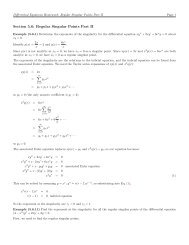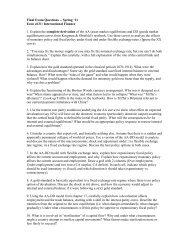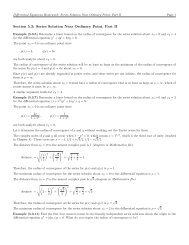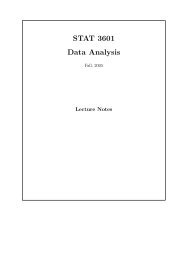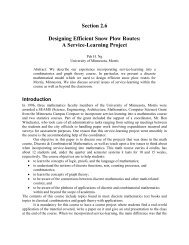Calculus I Homework: Linear Approximation and Differentials Page 1
Calculus I Homework: Linear Approximation and Differentials Page 1
Calculus I Homework: Linear Approximation and Differentials Page 1
You also want an ePaper? Increase the reach of your titles
YUMPU automatically turns print PDFs into web optimized ePapers that Google loves.
<strong>Calculus</strong> I <strong>Homework</strong>: <strong>Linear</strong> <strong>Approximation</strong> <strong>and</strong> <strong>Differentials</strong> <strong>Page</strong> 6<br />
Verify the linear approximation at 0 for the sine function, sin x ∼ x. Use a graphing device to determine the values of x<br />
for which sin x <strong>and</strong> x differ by less than 2%. Then verify Hecht’s statement by converting from radians to degrees.<br />
Consider the function f(x) = sin x, <strong>and</strong> we will choose a center of a = 0.<br />
We need the function <strong>and</strong> derivative evaluated at a = 0:<br />
f(x) = sin x<br />
f(0) = sin 0<br />
= 0<br />
f ′ (x) = cos x<br />
f ′ (0) = cos 0<br />
= 1<br />
L(x) = f(a) + f ′ (a)(x − a)<br />
= f(0) + f ′ (0)(x − (0))<br />
= 0 + 1(x)<br />
= x<br />
So we have shown that sin x ∼ x if x ∼ 0.<br />
If we want the approximation to be good to 2%, then the difference between the two should be less than 2%. The easiest<br />
way to find when this happens is to plot y = |(sin x − x)/x|.<br />
Here is a sketch of this situation.<br />
From the sketch, it looks like they differ by about 2% when x = 0.35 radians = 360(0.35)/(2π) = 20.0535 ◦ .<br />
Instructor: Barry McQuarrie Updated January 13, 2010





